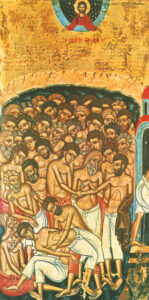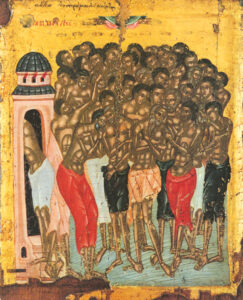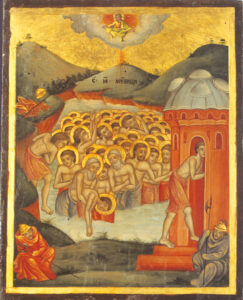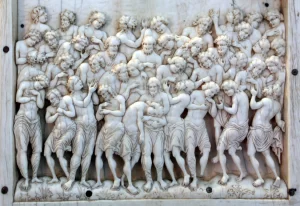How would you like to go swimming in a lake in Sivas, Turkey * on March 9, when the average high temperature is 46°F (8°C) and the average low temperature is 36°F (2°C)? No? Trip Advisor gives a nearby lake (Godpinar Golu) a five star rating. You still say that on the whole you’d rather not?
- the Pontic Greek/Roman city of Sebaste, near the south shore of the Black Sea
But what if your choice were either to deny your Lord Jesus Christ or to spend the night in that cold, cold lake? What then?

First: an Explanation and an Attribution
None of what follows this section of this Post is my own writing. As I explained a couple or three weeks back, I am unexpectedly “un-retired” and am interim pastor at the church from which I retired ten years ago – Saint Nicholas, Cedarburg, Wisconsin * – till a new pastor is appointed. I began this Blog five years ago to keep me busy in my retirement. Suddenly I’m double-busy! I’m not going to give up the Blog, even temporarily. I’d miss you! So please be patient with me if I have to punt occasionally till I “re-retire”.
- Here’s the story of how Saint Nicholas founded our parish 35 years ago: https://frbillsorthodoxblog.com/2019/05/03/124-how-saint-nicholas-founded-saint-nicholas-church-cedarburg/
I’ve taken most of what follows, with his permission, from John Sadinopoulos’ Blog, “Orthodox Christianity Then and Now”, which contains an enormous amount of information about the saints and much more. Just for an example, here is the link to the multitude of material he has collected about the Forty Martyrs.
https://www.johnsanidopoulos.com/2016/03/holy-forty-martyrs-of-sebaste-resource.html
If you have time to keep up with even a small portion of Mr Sadinopoulos’ Blog each day, you’ll be richly rewarded. (You also might contribute to help keep his work going.)
Now to the Forty Martyrs:

The Church’s Synaxarion for March 9: The Forty Holy Martyrs of Sebaste
The Names of the Forty Martyrs
Martyrs should be honored and remembered by name:
Cyrion (or Quirio), Candidus, Domnus, Hesychius, Heraclius, Smaragdus, Eunocius (Or Eunicus), Valens, Vivianus, Claudius, Priscus, Theodulus, Eutychius, John, Xanthius, Helianus, Sisinius, Aglaius, Aetius, Flavius, Acacius, Ecdicius, Lysimachus, Alexander, Elias, Gorgonius, Theophilus, Dometian, Gaius, Leontius, Athanasius, Cyril, Sacerdon, Nicholas, Valerius, Philoctimon, Severian, Chudion, Aglaius, and Meliton.
The Forty Holy Martyrs of Sebaste
by St. Nikolai Velimirovich

Fascinating Facts regarding the Forty Holy Martyrs of Sebaste
by Father Dan Graves (priest and writer in the Anglican Diocese of Toronto)
It was one of the strangest episodes in all of military and Christian history–an army killing its own best soldiers. The time: A.D. 320. The place: Sevaste, in present-day Turkey. The issue: Would Christian soldiers obey and bow to pagan gods?
320. The place: Sevaste, in present-day Turkey. The issue: Would Christian soldiers obey and bow to pagan gods?
How many agreed to sacrifice?
A legion consisted from 3,000 to 6,000 infantry plus cavalry. Apparently at least 2,960 men from the Sevaste legion sacrificed at Licinius’s order. Barely 1% bucked his demand!
The famous Thundering Legion.
The legion stationed at Sevaste may have been the famed Thundering Legion. Dating back to Caesar Augustus, it took its name from a lightening emblem on its shields. The Thundering Legion is connected with another unusual historical event. During the reign of Marcus Aurelius, it was trapped in a dry valley and only saved from dying of thirst by a furious thunderstorm which provided drinking water and threw enemy soldiers into panic. Christian writers spoke of the thunderstorm as a miracle in answer to the petitions of a group of praying Christian soldiers. Pagan authors attributed it to sorcery or to the prayers of Marcus Aurelius.
Why a legion of troops in Sevaste?
Licinius had to defend against Barbarians and Persians. Sevaste (now Sivas, Turkey) was a logical place to station a sizable force to meet challenges from North and East.

Save the remains.
The bodies of the Forty were burned and their ashes cast into a river. The current deposited fragments of bone at a bend in the stream. Christians collected and preserved them as honored remains to be kept among local churches.
Sevaste (now Sivas, Turkey) was in Armenia. It was a strategic location to station troops to meet threats from North and East.
Credible witnesses to the story.
Too Incredible to Be True? Are we really supposed to believe that forty men in the prime of life voluntarily undressed to die by freezing? Is this just a legend?
Actually, the story is as solid as ancient history gets. There are at least three sources for it. The men were martyred in 320. Gregory of Nyssa (c.335-396) tells that he was still a boy when a feast was established in their memory and churches dedicated to them. He wrote two sermons on them and declared his intention to bury his parents beside the remains of some of the brave soldiers.
When Gregory’s brother, Basil the Great, Bishop of Caesarea (c.330-379), preached a sermon on the feast day of the Forty Martyrs, there were still men and women alive who remembered the brave fellows. Basil’s sermon, by the way, is the oldest written record we have of their icy death, and was preached in a church named for the Forty Martyrs.
Another person who later wrote about the martyrs was actually alive as a fourteen year old boy when they spent their night on the ice. Ephraim the Syrian (c.306-373) became a leading Christian scholar and hymn writer. He spent much of his life in Edessa, about two hundred miles south of Sevaste. Among his many poems was a eulogy on The Forty.
The Day the North Wind Did Blow.
“The day was very cold. Surely I do not have to inform you about the cold since today’s weather gives you a clear idea about it. The chill even penetrates the walls….such was the season of the contest and the time of their miracles when the north wind blew so vehemently.” – Gregory of Nyssa’s 1st Sermon on the Forty Martyrs
Did Licinius Kill for Spite?
It is commonly and inaccurately stated that Constantine made Christianity the official religion of the Roman Empire when he became emperor. Not so. It was Theodosios I over a half-century later with his edict of 380. Constantine actually came to power with a co-emperor Licinius.
In 313, Licinius needed Constantine’s help and struck a deal with him. To seal the bargain, Constantine married his sister to Licinius. The two generals issued the edict of Milan, granting religious toleration to the empire. Licinius even fought under a Christian banner.
So what changed? Why did Licinius turn on the Christians in 320? Both wanted the same thing –single control over the empire. Persecuting Christians was one way for Licinius to show how much he hated Constantine, whose favor for the Christian faith was well known.
Out of Place Christians?
What were Christians doing in the army? Early Christian writers tell us that Christians believed it was wrong to fight and kill. Could it be that The Forty were draftees? Or had Christians decided it was okay to fight as long as they did so under a Christian banner? Perhaps the men converted to Christ after enrolling in the armed forces.
A Miracle of the Holy Forty Martyrs of Sebaste at Dachau Concentration Camp
“During the years of the German Occupation I was arrested by the Germans, together with my brother according to the flesh Papa-Panteleimon, and they took us to Dachau. One night they took us outside to execute us. It was winter and they undressed us. We waited for our turn. There was no hope for our salvation.
Then I remembered the Holy Forty Martyrs, and I turned and said to him: ‘Hey, Panteleimon! What’s the Apolytikion to the Holy Forty Martyrs? Do you know it?’
Then Father Panteleimon began to chant in the first tone:
‘We entreat You, O Lord, by the sufferings endured for You by the Saints, and we pray You, who loves mankind, heal all our pain.’
Immediately after this, a warmth wrapped itself around the both of us, and we did not feel the cold. It was the presence of the Saints, who themselves suffered from the cold.
The night passed and the morning came. While we awaited death, an order came for us two monks to not be executed. No one survived, except us. This is why they wrote our names on a sign of the executed there at the camp.”
Next Week: Advice from the Fathers on how to keep the Fast
Week after Next: The Akathist Hymn to the Mother of God

